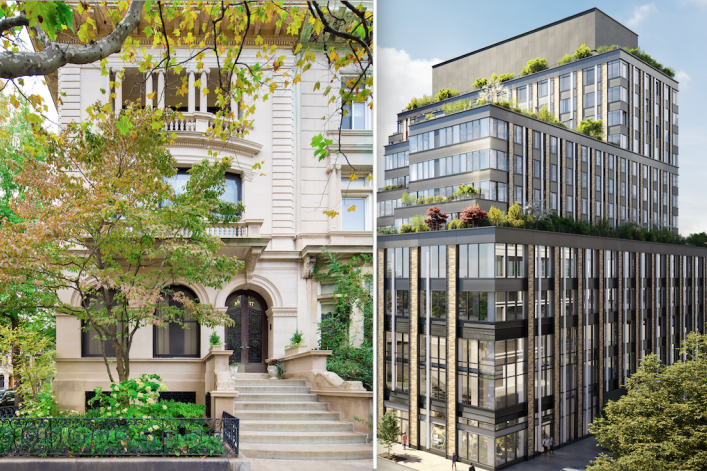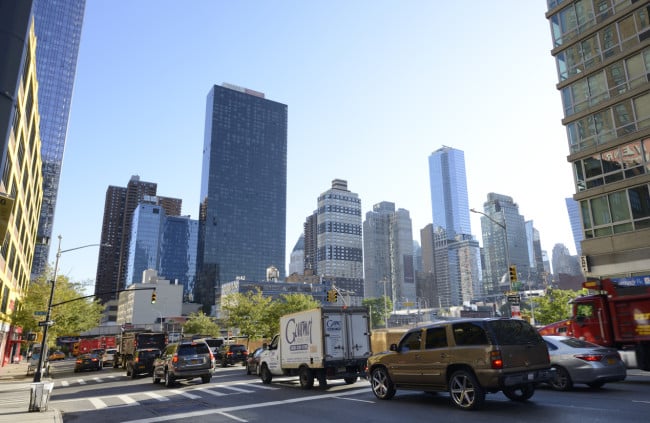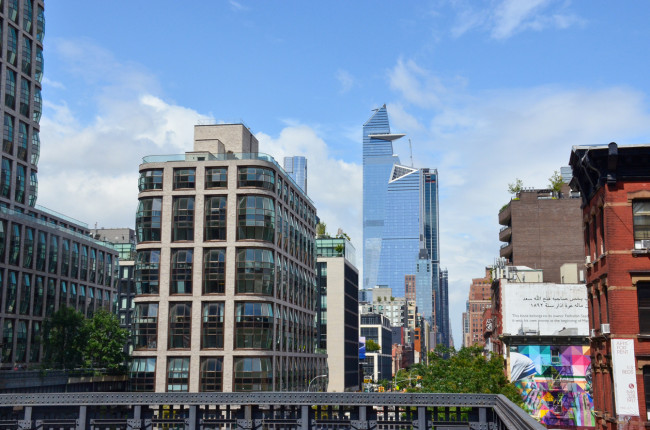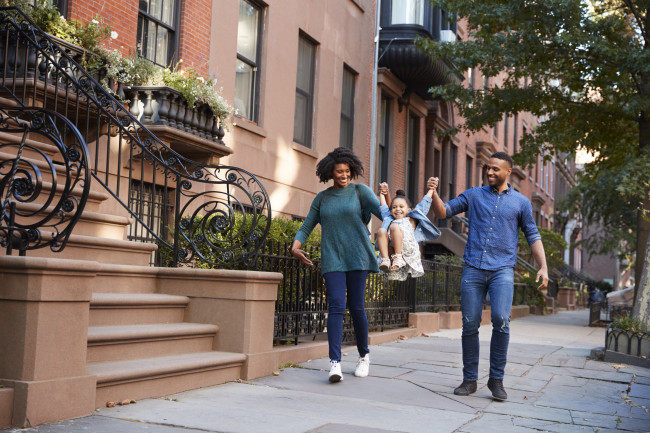Has the pandemic changed what is a trophy property in NYC?

Status symbols: 17 Prospect Park West, left a 1899 limestone brownstone overlooking Prospect Park West is on the market for $12.25 million. On the right is a rendering of One Essex Crossing, which launched sales this year and has two penthouses in contract with asking prices of $6.585 million and $5.685 million, according to StreetEasy.
Are high-end buyers more interested in the privacy they can get with a brownstone as opposed to a luxury apartment like a penthouse?
It is a question to consider as the New York City sales market prepares to welcome back foreign buyers November 8th. That's when international travelers who are fully vaccinated can start to enter the U.S. Several brokers say the pandemic shifted preferences at least for some luxury buyers toward brownstones. Some owners who gave up their NYC pieds-à-terre in buildings that imposed strict rules during the pandemic are expected to gravitate toward brownstones when they return to the market.
Brownstone sales got a boost from domestic buyers looking for private outdoor space and privacy, as the pandemic appeared to shift buyers' top priorities. There’s no riding the elevator or sharing amenities with neighbors when you own the building.
However, one broker says those preferences will not be the sole determinant for sales.
“When the market first made a comeback, there was a big demand for brownstones as the allure of low density, privacy, and outdoor space was high,” says Ruthie Assouline, a broker with Compass. “Now that there are vaccines available, I think these requirements have become less important. We are seeing a huge increase in the demand for penthouses—and many going into contract. In the current market, I wouldn’t say one is better than the other as both are very desirable.”
One reason is that penthouses offer plenty of privacy too. They often take up a full floor and many have their own elevator—and private outdoor space with incredible views. Being on a high floor has lots of perks—including resale value. Penthouses tend to sell for about 5 to 10 percent more than non-penthouse apartments and tend to be less affected by market volatility as a result, Jonathan Miller, president and CEO of appraisal firm Miller Samuel previously told Brick.
Luxury properties—which are priced $4 million and above—are seeing a record number of sales these days. According to the Olshan Report, 50 high-end Manhattan homes asking $4 million or more went into contracts during the week ending October 24th—the third time this year 50 or more luxury contracts were signed and nine more than the previous week.
Condos outsold co-ops 52 to 5, and there were five townhouses in the mix. The top contract was a penthouse at celebrity favorite 443 Greenwich St., asking $49.5 million, originally listed for $57 million in 2019.
No board restrictions on renovations
For owners looking to renovate, not having to answer to a co-op or condo board can make the process much simpler in a brownstone—aside from getting permits from the city, there’s no waiting list or alteration agreement to abide by, or restrictions on how many workers you can have and when they can be in the building.
Still, owning a brownstone is usually acknowledged as a more “hands-on” type of ownership, Assouline notes. Managing upkeep is your responsibility, and that can be a drag on your time.
But that’s where the property managers come in, Lindsay Barton Barrett, a broker at Douglas Elliman, explains.
She represents 17 Prospect Park West, a brownstone overlooking Prospect Park in Park Slope, Brooklyn, which she describes as “big and grand with the wow factor of a penthouse.” The asking price? $12,250,000.
Visitors are often stopped in their tracks with an “oh-my-gosh” type of reaction, she says.
The 1899 limestone brownstone has seven bedrooms, three-and-a-half baths and 6,232 square feet. She likens it to a piece of art, thanks to its architectural details. The 25-foot-wide property has stained glass windows, mahogany columns, herringbone floors, carved mantels and five working gas fireplaces. “An incredible statement piece,” she calls it.
For most buyers, the advantage of brownstone living is the fact that you can be home with your family without being on top of each other all the time—thanks to all that vertical space.
The perk of being the owner of your own building is typically considered to be offset by a big drawback: There’s no staff or super on hand to call when something breaks down or you’re expecting a package or need someone to gain access to oversee work being done. But that’s not necessarily a problem. Barton Barrett says buyers at all price ranges can get help with things around the house.
“You can always hire someone to shovel your walk or even get a live-in house manager. Or you can hire a company that hires staff for you. It’s NYC, you really can get everything,” Barton Barrett says.
She points out that penthouse owners have some responsibilities that new buyers may not consider. In new developments, units often have separate utilities—like separate water heaters for each unit—which can require some more attention from owners than the usual luxury apartment. (Developers do this so utilities don’t show up on common charges, plus it’s easier to do more electric in new buildings—instead of putting in gas lines.) Owners with large outdoor space are responsible for landscaping and shoveling snow, for example.
Luxury owners ‘don’t want to be told no’
Vickey Barron, a broker at Compass, sold three NYC townhouses to buyers from Seattle and California who hired property managers to collect packages and maintain the property. She also represents sellers at the Four Seasons, which is popular with international buyers. Baron previously told Brick that she expects some international buyers will be shifting their attention from condos to luxury townhouses because during the height of the pandemic, many high-end buildings implemented strict rules about visitors.
“People at a certain luxury level want to call the shots,” she says. “If they want their chef or cleaning person or accountant to come, they don’t want to be told [no].”
New development appeals to foreign buyers
Jad Cary, sales director at Corcoran Sunshine Marketing Group, says the pandemic caused some luxury buyers to turn their attention from penthouses to brownstones because of concerns about shared amenities.
But on the Lower East Side, where he represents sales at One Essex Crossing, there are few brownstones and townhouses. Luxury properties there are new developments and One Essex Crossing has already sold over $45 million worth of residences since launching sales earlier this year, including two of the building’s penthouses, which were bought by longtime LES residents.
Penthouses appeal to professional couples who are working from home these days, he notes, and some luxury buyers who would typically look at a one bedroom or two bedrooms now want three bedrooms. He says one of the penthouses he sold, with 2187 interior square feet and 907 exterior square feet—and three-bedrooms—was purchased by a bachelor.
“What penthouses have over brownstone and other condos is the view,” he says. And luxury buyers are reasoning that if they’re going to be spending lots of time in an apartment, they want open views, he adds. One Essex Crossing, for example, spans an entire city block in a low-rise neighborhood. At 13 floors with penthouses on the 14th floor, it's not a tall building, so the views are not from an extreme height.
New development has typically been preferred by international buyers, Cary notes. (Foreign buyers have an easier time buying a condo as opposed to a co-op.)
“Now that we’re welcoming fully vaccinated international visitors as of November, “we will start to see a lot more new development sales.” Up until now, he’s been doing lots of virtual tours but international luxury buyers don’t want to spend unless they can “see and touch.”
Which type of property has more status today?
Which is a bigger status symbol these days, a penthouse or a brownstone?
“Some buyers might consider a penthouse in a highly discerning, all-cash Upper East Side co-op while others would consider owning a townhouse in NYC to be the bigger symbol as these can often have a storied history behind not only their creation but their former owners as well. They can also fetch a price to rival some of the most expansive penthouse apartments,” says Matthew Hughes, a broker at Brown Harris Stevens.
He represents 60 Sutton Place South, #PH19BS, a three-bedroom, four-and-a-half-bath penthouse with East River views and three private terraces, asking $6,175,000. The outdoor space alone totals 1,175 outdoor square feet:
“Brownstones will typically have nowhere near the clearance of a penthouse apartment, but what you lack in sweeping views you make up for in privacy, overall square footage, and autonomy. However, with that autonomy comes less security,” Hughes says.
“The beautiful thing about NYC is that no two buildings are the same, not even brownstones,” Hughes says. “Status symbols depend on the company you keep. Luckily, it’s New York City—and there’s something here for everyone.”
You Might Also Like



























